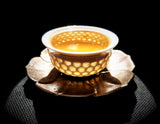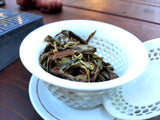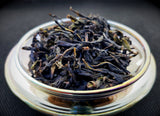Grown on Wudong Peak, the most prized of all the tea-growing regions of the Phoenix Mountains. The teas produced in this region (wulongs, except in rare cases) tend to be bold, floral, fruity, and foresty. Dry, the leaves of this tea appear a dark, almost black army green and rusty brown, with accents of yellow, and carry a lively floral aroma with hints of plum and jasmine. Wet, they are seaweed and forest green, and have a vibrant, green, almost seaweedy aroma, reminiscent of a rich, verdant forest. This golden brew has a floral, sweet, delicate bouquet, balanced by a bright, green, jungle flavor with elements savory bakery sweetness, stone, and wild grass. Its texture is silky-smooth, and somewhat dry.
Take care in brewing this tea, as it is quite sensitive, and its bitter elements will be heavily accentuated if over-steeped. You take care of it and it'll take care of you.
If this tea were a person, it would be a jade-clad mystic, who rides a white tiger through the jungle, beads woven through their long hair. The tiger would frequently stop for water at an idyllic jade pool, deep in the forest, where this mystic would sit and meditate, surrounded by pristinely clear waters. While carefree, this character would be one who is truly disciplined in their mystical practice.
Lasts 5-15 brews.
(Phoenix wulongs are not traditionally brewed more than five times, but you do what you want.)
Nomenclature: The Chinese name for this tea is 玉兰香單叢/玉兰香单丛
玉 - Yù - Jade. In Chinese myth, jade comes from dragons. It is one of the primary auspices of Chinese culture, and it is said that the shine of a piece of jade jewelry will be proportional to the vitality of its wearer. It is also said, should a piece of jade become broken, that this served as a substitute sacrifice for the life of its wearer, and that, if the wearer had not possessed that jade to be broken, their life would have been lost.
蘭/兰 - Lán - Orchid, ornate, elegant. This is one of the four flowers knowns as the "Four Gentlemen" or "Four Sages." These Four Sages are used to represent the seasons of the year, and are found throughout Chinese art and culture. Among the four (plum, orchid, bamboo, and chrysanthemum), the orchid represents Spring, and its character is said to be elegant and etheric.
It is a common practice, in China, to construct flowers and trees from precious stones, such as jade. Thus, while Jade Orchid is a flower all its own (a type of magnolia), this name also evokes the image of a stunningly beautiful orchid, each petal elegantly crafted from the finest, most perfect jade, shining and luminous.
香 - Xiāng - Fragrance. Most Dancong wulongs contain this character, such as Honey Orchid Fragrance, Duck Shit Fragrance, Almond Fragrance, Yellow Stick Fragrance (Huang Zhi Xiang), etc.
單/单 - Dān - Single.
叢/丛 - Cóng - Bush, shrub.
The teas of the Phoenix Mountains are referred to as *Dāncóng (單叢/单丛), meaning "single bush." This is because, traditionally, the leaves from each of tea bush would be kept separate, allowing one to taste the flavor produced by one particular bush. While this is no longer standard practice in the Phoenix Mountains, the teas of this region have retained the name.
*(The "c" in Chinese is pronounced "ts.")
Price is per 50 grams/1.76 ounces







